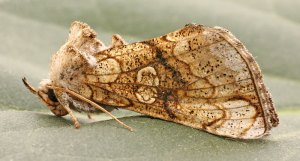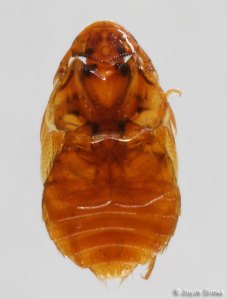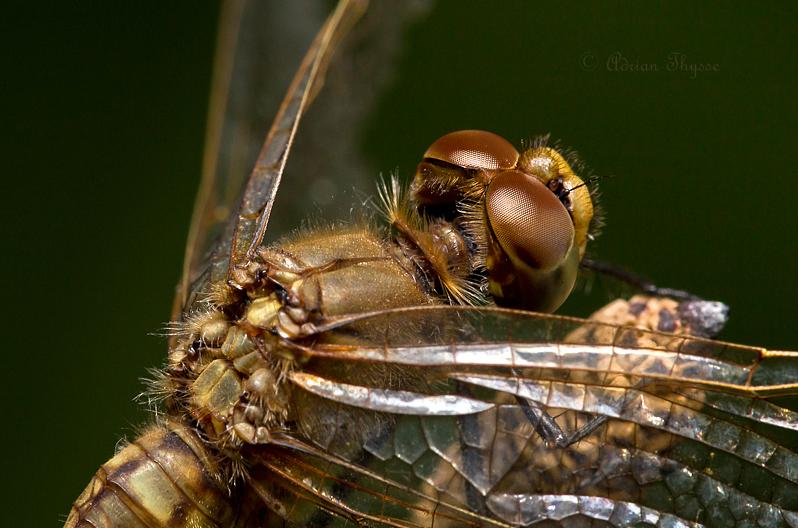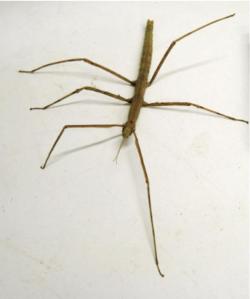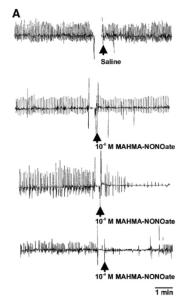(Note: the English version follows)
Guillaume Dury, Étudiant à la maîtrise, Université McGill
_______________________________

Dessous de Chrysiridia rhipheus, photo par Cody Hough sur Wikimedia Commons.
Le 7 avril 2012, l’article du jour sur Wikipédia était Chrysiridia rhipheus.
C’était un grand jour pour moi : j’ai écrit la majorité de l’article. Ce n’est pas pour autant mon article; dire cela irait à l’encontre de l’étiquette de Wikipédia. J’y ai tout de même passé des heures de recherche et j’ai écrit la majorité de l’article.
Tout comme des millions de personnes, j’utilise Wikipédia pour étancher ma soif de connaissances rapides. À juste titre, « «wiki» » est Hawaïen pour rapide. Seulement, il n’y avait pas de wiki-connaissances sur ce papillon de nuit qu’est l’Uranie riphée (Chrysiridia rhipheus).
J’étais toujours curieux; cette soif particulière ne resterait pas inassouvie. Puisque j’allais faire une recherche de littérature, aussi bien écrire un résumé au bénéfice des autres. Voilà comment je suis devenu un éditeur sur Wikipédia.
J’ai créé l’article le 5 août 2006, un peu avant de commencer mon baccalauréat en biologie. En tant que biologiste de formation, j’avais besoin de pratiquer les tâches concernées dans l’écriture de l’article. Le plus important fut de trouver l’information. J’ai pu trouver beaucoup d’information en ligne : dans les articles scientifiques et dans des livres numérisés par Google Books ou Internet Archive. J’ai aussi appris que, parfois, des références ne sont tout simplement pas disponibles en ligne. C’est alors que j’ai utilisé les prêts entre bibliothèques pour la première fois. Peu a peu, une référence à la fois, j’ai rempli les différentes sections de l’article.
La partie sur la taxonomie et la description de l’espèce fut beaucoup plus intéressante à écrire que je l’aurais cru. L’Uranie rhiphée, ou le « «papillon coucher de soleil malgache» » (de l’anglais « Madagascan sunset moth ») a toute une histoire derrière ses noms. Il est décrit pour la première fois, en 1773, sous le nom de Papilio rhipheus. C’est-à-dire qu’il avait été placé parmi les papillons de jour et non de nuit. Capitaine May de Hammersmith avait donné le spécimen à l’entomologiste britannique Dru Drury. Ce spécimen avait été « «réparé» » avec une tête de papillon de jour et ses antennes en massue. (NB : ne pas coller la mauvaise tête sur votre spécimen cassé!) En 1831, René Primevère Lesson l’avait décrit sous le nom Urania ripheus var. madagascarensis. Ce papillon a toujours plusieurs autres synonymes.
En utilisant les guides sur Wikipédia, en demandant d’autres éditeurs et en m’inspirant de d’autres articles, j’ai rassemblé et résumé de plus en plus d’information. J’ai fait passer l’article par le processus interne d’évaluation par les pairs dans Wikipédia en janvier 2007. Sur Wikipédia, les pairs sont d’autres éditeurs et pas nécessairement des entomologistes. Cela a aidé un peu, surtout pour le format article, mais je devais surtout trouver d’autres sources d’information à inclure.
Puis, j’ai contacté l’un des experts mondiaux sur Chrysiridia rhipheus, le Dr David C. Lees du Musée d’Histoire naturelle de Londres. J’ai été agréablement surpris; il était déjà éditeur sur Wikipédia. Il m’a dirigé vers des références importantes que j’avais manquées et a ajouté des informations lui-même. J’étais ravi.

Carte de cigarettes dépeignant une fée « Chrysiridia madagascariensis » en 1928, compagnie John Player & Sons.
En mars 2008, je jugeais que mon article avait atteint le niveau de « «bon article» ». Pour être reconnu comme tel, un article doit répondre à certains critères et passer avec succès le processus de mise en candidature de bon article. Avec l’examen et des suggestions de l’utilisateur Casliber, c’est ce qui s’est passé le 22 mars 2008 : j’avais écrit un « «bon» » article sur Wikipédia.
J’ai continué; j’ai fait des modifications, j’ai ajouté des références, des images, y compris une carte de cigarettes datant de 1928, et j’ai ajouté ce qui est probablement la seule photo de la chenille de cette espèce sur Internet. J’ai eu l’aide de l’un des principaux éditeurs des articles sur l’optique et la polarisation des articles afin de clarifier pour moi la polarisation de la lumière. Les écailles sur les ailes du papillon produisent les couleurs à travers deux phénomènes optiques, l’un dépend de polarisation. Le papillon ne dispose de pigment que dans les régions noires de ses ailes.
Ensuite, le 18 juin 2008, j’ai fait la mise en candidature de l’article pour qu’il soit reconnu comme article de qualité. Les articles de qualité sont considérés comme représentant le meilleur de ce que Wikipédia a à offrir, comme déterminé par les éditeurs de Wikipédia. Lors de ce processus, de nombreux éditeurs font des suggestions et demandent des changements à l’article. J’ai fait la plupart de ces changements et fait de mon mieux pour répondre aux questions. Le 4 juillet 2008, Chrysiridia rhipheus a été promu au statut d’article de qualité. Featured article en anglais; ce statut exceptionnel est signifié par une petite étoile dans le coin supérieur à droit! :
http://en.wikipedia.org/wiki/Chrysiridia_rhipheus
En moyenne, l’article Chrysiridia rhipheus est visité à peu près une centaine de fois par jour. Le 7 avril 2012, il a été visité plus de 20 000 fois. Au cours des 90 derniers jours, cela fait un total de 37614 fois. C’est de la bonne diffusion!
Je répondrai avec plaisir aux questions de ceux qui s’intéressent à l’écriture de « leur propre » article Wikipédia. Tout commence par le bouton [modifier]…
Pour les professeurs : « «dans le cours ENTO 431 entomologie médico-légale, à l’université du Texas A & M, les étudiants ont la tâche d’écrire plusieurs articles sur Wikipédia concernant les espèces de mouches d’importance médico-légale.» » Le travail des étudiants sert alors leur cours et sert le but de Wikipédia de créer un résumé de toutes les connaissances humaines dans une encyclopédie libre et en ligne. (Pour plus d’informations, voir la page du cours sur Wikipédia (en anglais))
____________________________
By Guillaume Dury, M.Sc. student, McGill University
____________________________

Engraving captioned Urania riphaeus from Charles D. d’Orbigny’s Dictionnaire universel d’histoire naturelle (1849)
On April 7th 2012, on Wikipedia, Today’s Featured Article was Chrysiridia rhipheus.
It was an exciting day for me: I wrote most of the article. It isn’t my article; it would be against Wikipedia etiquette to say so. Still, I spent hours researching and wrote most of it.
Just like millions of people, I use Wikipedia to quench my thirst for quick knowledge. Appropriately, “wiki” is Hawaiian for quick. Only there was no wiki-knowledge on the Madagascan sunset moth (Chrysiridia rhipheus).
I was still curious; this particular thirst wouldn’t be left unquenched. Since I would search the literature, I thought I might as well write a summary for the benefit of others. That is how I became an editor on Wikipedia.
I created the article on August 5th 2006, a little before starting my bachelor’s in biology. As a biologist in training, I needed to practice the tasks involved, most importantly: finding information. I was able to find a lot online: in scientific articles and scanned books in Google Books or Internet Archives. I also learned that sometimes, references are simply not available online. That is when I used interlibrary loans for the first time. Little by little, one reference at a time, I filled the different sections of the article.
The section on taxonomy and naming of the species was a lot more interesting to write than I initially thought it would be. The Madagascan sunset moth has quite a story behind its names. It was first described, in 1773, as Papilio rhipheus. That is to say, it was described as a butterfly and not a moth. Captain May of the Hammersmith gave the specimen to the British entomologist Dru Drury, only that specimen had been “repaired” with a butterfly head that had clubbed antennae. (N.B.: don’t glue the wrong head on your broken insect specimen!) In 1831, René Primevère Lesson described Urania ripheus var. madagascarensis. The moth also has a number of other junior synonyms.
Using guides on Wikipedia, asking other editors and inspiring myself with other articles, I gathered and summarized more and more information. I went through Wikipedia’s internal process of peer review in January 2007. On Wikipedia, peers are other Wikipedia editors, not necessarily entomologists. This helped somewhat, especially for article format, but I really had to look for more sources and information to include.
I contacted one of the world experts on the Madagascan sunset moth, Dr. David C. Lees of the London Natural History Museum. I was pleasantly surprised he was already an editor on Wikipedia. He pointed me towards important references I had missed and added information himself. I was delighted.

A cigarette card featuring a « Chrysiridia madagascariensis » fairy in 1928 from John Player & Sons.
In March 2008, I felt my article was close to the level of “Good article”. To be recognized as such, an article needs to meet the good article criteria and to successfully pass the good article nomination process. With the review and suggestions of user Casliber, this happened on March 22nd 2008: I had written a “Good” article on Wikipedia.
I kept going, did more editing, added references and pictures, including a cigarette card from 1928, and what is probably the only photo of this species’ caterpillar on the Internet. I got help from one of the main editor of the articles Optics and Polarization to clarify light polarization for me. The scales on the moth’s wings use two optical phenomena to produce the colours, one of which is polarization dependent. The moth only has pigment in the black regions of its wings.
On June 18th 2008, I proposed the article for evaluation to be recognized as Featured. Featured articles are considered to be the best Wikipedia has to offer, as determined by Wikipedia’s editors. In this review process, various editors make suggestions and ask for changes to the article. I made most of those changes and answered questions to the best of my knowledge. On July 4th 2008, Chrysiridia rhipheus was promoted to Featured Article, this exceptional status is signified by a little star in the top-right corner!:
http://en.wikipedia.org/wiki/Chrysiridia_rhipheus
On an average day, the article Chrysiridia rhipheus is viewed roughly a hundred times. On April 7th 2012, it was viewed over 20 000 times. In the last 90 days, that makes a total of 37 614 times. Good exposure!
I’ll happily answer the questions of anyone interested in writing « their own » Wikipedia article. It all start with the [edit] button…
Lastly, a note for the professors: « As a part of the ENTO 431, forensic entomology course at Texas A&M University students are assigned the task of writing several articles at Wikipedia pertaining to forensically important fly species. » The students’ work serves their course, and Wikipedia’s goal to create a summary of all human knowledge in an online encyclopedia. (For more information see the course’s Wikipedia page)
 Hi! I’m a PhD candidate in Chris Buddle’s Arthropod Ecology lab at McGill University. My current research interests include beetle assemblages in Arctic Canada and functional ecology. My earlier research at Carleton University (I did a BSc and MSc under the supervision of Naomi Cappucinno) involved plant-insect relationships in the context of biological invasions.
Hi! I’m a PhD candidate in Chris Buddle’s Arthropod Ecology lab at McGill University. My current research interests include beetle assemblages in Arctic Canada and functional ecology. My earlier research at Carleton University (I did a BSc and MSc under the supervision of Naomi Cappucinno) involved plant-insect relationships in the context of biological invasions.




